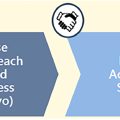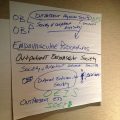Office based interventional procedures continue to increase in number and scope. An overview of the Outpatient Endovascular and Interventional Society (OEIS) National Registry (OEISNR) is described in this article. Currently there is one production module enrolling peripheral artery interventional procedures, and a new cardiac module encompassing both diagnostic catheterization/percutaneous coronary interventions and electrophysiology procedures is undergoing beta testing. A new embolization module with uterine fibroid embolization (UFE) as the initial modality is nearly initial development completion and expected to enter beta in 2024. The OEISNR has over 338 participating physicians and has enrolled over 42,000 cases since inception in 2017 with an extremely high rate of technical success (97%) and very low complication rates (2.15% overall, 1.65% minor complications, 0.53% major complications). More detailed data breakdowns including patient demographics and comorbidities, indications, lesion characteristics, treatment modalities and device utilization, complication details, and data integrity data are contained in this report. Sample analytics, sample dashboards, and structural details are illustrated and included.
Introduction
Over the past 15 years there has been a steady and rapid increase in the number and complexity of endovascular procedures safely performed in the office-based interventional suite or office-based lab (OIS/OBL). , , This shift in location from the hospital-based environment to the office has been accompanied by marked increases in both patient and physician satisfaction with procedures performed in the OBL and both patients and physicians prefer the OBL over hospital-based care. , Despite the acceptance by both patients and the physicians who operate in the OBL space, concerns have been raised regarding appropriateness and financial incentives in this site of service in both the medical literature and, at times, sensationalized by the lay press. , Nearly all of the referred medical literature to date has used Medicare claims data as a primary data source, thus the data is based on ICD-10 diagnostic codes, CPT procedural codes, and site of service listings. Even subsequent large scale outcomes data is also based on Medicare claims data/codes primarily relying on repeat procedural codes, amputation codes and life/death data. Much of this controversy has been engendered by inappropriate use of Medicare Claims data, and by a gross misunderstanding of the economics of the OBL space. Unfortunately, perilously little large-scale, multi-center, or prospective study using actual clinical data has been available to help adjudicate some of these controversies. As W Edward Demming once famously said “Without data you’re just another person with an opinion.”
Participation in a quality clinical data registry is one way to collect procedural and peri-procedural data to address these and other questions on a much broader basis. Such registries enable the collection of clinically relevant data about a specific disease state, condition, or procedure(s) with the goal of documenting and understanding basic patient characteristics and demography, disease morphology and expression, risks and exacerbating factors, procedural characteristics, and outcomes. Specialty registries or those with a particular clinical emphasis may also concentrate on tracking data such as safety and efficacy, complications, cost data, and any other cogent variables and factors. The data can then be analyzed to allow the assessment and provide useful information regarding real world practice patterns, clinical pathways or guidelines, risk stratification, cost/benefit ratios, optimal use of new or existing treatments or devices, and potential contraindications.
The OEIS National Registry (OEIS NR) was founded to meet these exact needs and provide physicians performing procedures in the OBL/ASC environment a robust but relatively easy to use and cost-effective clinical registry vehicle. The OEIS NR has maintained status as a CMS certified Qualified Clinical Data Registry (QCDR) signifying it has met the most stringent requirements imposed by the federal Medicare program and allowing reporting of clinical quality data and improvement activities on behalf of enrolling physicians to the MIPs program.
Full descriptions of the background and design of the OEIS NR, as well as comparisons to competing registries such as VQI, have been described in recent publications. , The OEIS NR uses a proprietary web-based electronic data capture (EDC) system, and the back end is based on enterprise grade non-SQL database structure. The web-based EDC and middleware is owned and administered by Syntactyx (New York, NY) and the non-SQL databases are Mongo DB (MongoDB Inc). Syntactyx is now a wholly owned subsidiary of NAMSA (North American Science Associates LLC). This structure has allowed great flexibility in the design and implementation of the database as well as the ability to expand, enhance, and modify both the underlying data structure and the web-based collection forms to better serve the enrolling physicians as well as to help research and data analysis. There have been 2 major revisions to the structure and databases since 2017 and there are active, ongoing, minor enhancements/maintenance functions occurring on a regular basis. Subscription to the OEIS NR is available to physicians/practices wishing to enroll cases at a modest fee which is significantly lower than competing registry products.
There are currently 338 physicians at 110 sites across the United States participating in the OEIS NR. Figure 1 shows the breakdown of specialties and geographic distribution of participating physician. About 70% are interventional cardiologists, followed by 19% vascular surgeons, and only 6.8% interventional radiologists—this is at odds with the specialty breakdown of OEIS members which approximates 33% in each of the major specialties (IC, IR, VS). It is the goal of the OEISNR to significantly increase the number of participating interventional radiologists (See Fig. 1 ).

Currently the OEIS NR peripheral arterial interventions module is in production and enrolling cases. A more detailed description and several figures showing the current module and the types of data captured screen shots of analytics/dashboards as well currently available to all OEIS NR subscribers will be detailed and shown below. A new cardiac module encompassing both diagnostic coronary angiography/percutaneous coronary intervention (PCI) as well as electrophysiology and rhythm management/CIED procedures has been designed and engineered and is currently in beta testing. It is expected that cardiac module will begin clinical enrollment in 2024. An embolization module is currently in development with uterine fibroid embolization (UFE) as the initial procedure for which data will be collected and is nearing completion of the initial development. The embolization module is expected to add multiple other therapeutic embolization modalities such as geniculate artery embolization, gonadal embolization, and chemoembolization as the project progresses. Planned future modules include deep venous/iliocaval interventions module, dialysis interventions module, and potentially other non-vascular procedural modules such as kyphoplasty.
Current Status of the OEIS NR
As noted above, the peripheral arterial interventions (PAD) module is currently enrolling cases in a full production mode. The OEIS NR is structured to collect basic patient and procedural demography, risk factors, co-morbidities, and an array of clinically relevant information including the ability to describe detailed lesion characteristics, specific and granular device information, follow-up results, and longer-term results.
Preliminary results were published in 2020 after the first 18,000+ cases were enrolled in the peripheral arterial interventions module beginning in January of 2017. The results demonstrated excellent technical success (>95%), extremely low complication rates (<2% overall) and negligible 30-day mortality (<0.03%). As of December 29, 2023, the registry now has greater than 42,000 cases enrolled with a 97% technical success, and 2.16% overall complication rate. Over 128,000 distinct interventions have been performed on over 68,000 lesions in >26,000 patients. Roughly 85% of cases have been performed in the OBL, with the remainder being conducted in the ASC. Just over 50% (50.63%) of interventions were performed with claudication as the primary indication, with most of the remaining cases (>40%) were performed for either chronic limb threatening ischemia (CLTI) or acute limb ischemia (∼4%). The vast and overwhelming majority of cases were planned interventional cases and nearly all were discharged home on the same day of the procedure. A total of 302 (0.71% of all cases) patients required peri-procedural transfer to a hospital between 2017-2023 (See Fig. 2 .)








